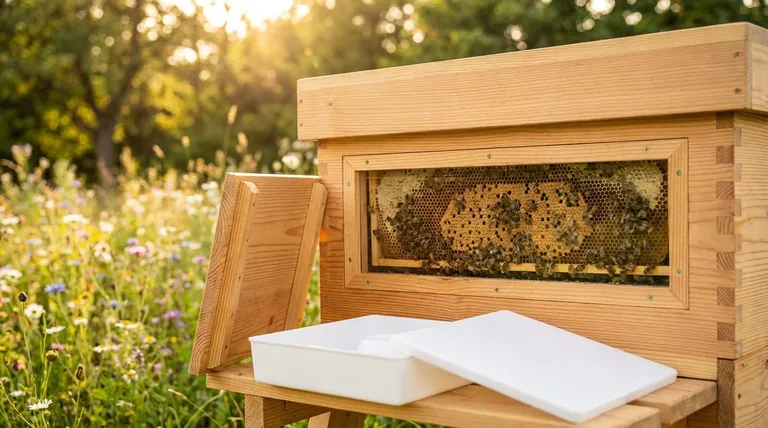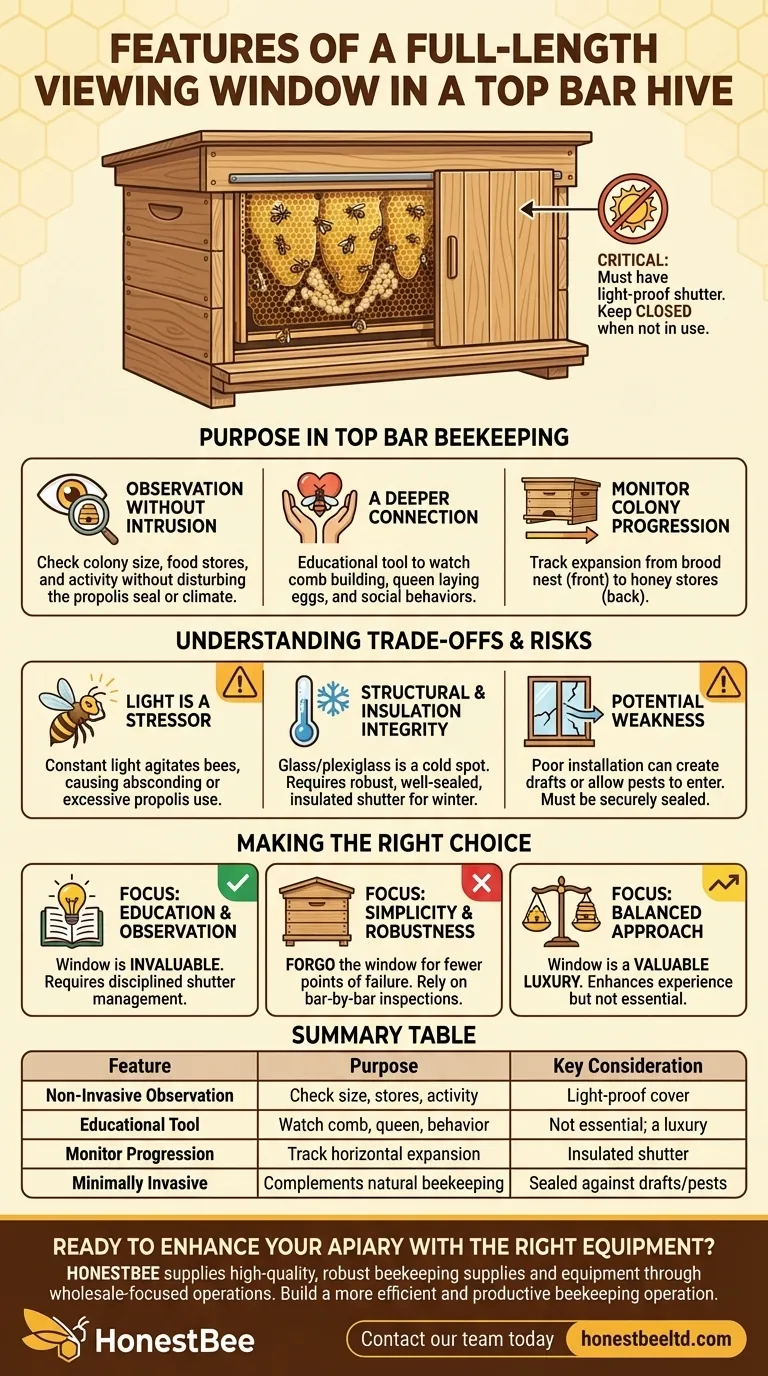A full-length viewing window is a popular but non-essential feature for a top bar hive (TBH) that allows a beekeeper to observe the colony's interior without opening the lid. Its primary design requirement is a tightly-fitting, light-proof cover or shutter that must be kept closed when not in use to protect the bees from light-induced stress.
A viewing window powerfully complements the minimally invasive philosophy of top bar beekeeping, offering a unique look inside the hive. However, its benefit is directly tied to disciplined use, as improper light management can harm the colony's health and stability.

The Purpose of a Window in Top bar Beekeeping
A top bar hive is a horizontal system where bees build their comb down from removable bars. A window on its long side offers a cross-sectional view of this natural environment, providing insights that are difficult to gain from other hive types.
Observation Without Intrusion
The core benefit is the ability to check on the colony without disturbing it. Opening a hive breaks the propolis seal, releases heat and humidity, and triggers a defensive response.
A quick glance through the window allows you to gauge the colony's size, see where they are clustered, and estimate their food stores without altering their environment.
A Deeper Connection to the Colony
For many beekeepers, the window is an educational tool. It allows you to watch bees build natural comb, see the queen lay eggs, and observe their intricate social behaviors in real-time.
This visual access fosters a deeper understanding of the honey bee life cycle, aligning perfectly with the natural beekeeping principles often associated with the top bar hive.
Monitoring Colony Progression
The horizontal layout of the hive means the colony typically expands from one end to the other. A full-length window lets you track this progress easily.
You can see the brood nest at the front, developing honey stores in the middle, and empty combs at the back, giving you a clear map of the hive's internal state.
Understanding the Trade-offs and Risks
While beneficial, a viewing window introduces variables that must be managed. It is not a zero-consequence feature and requires a mindful approach from the beekeeper.
The Critical Need for Darkness
Honey bees are cavity-dwellers that evolved to live in complete darkness. Light is a significant stressor for a colony.
If the window cover is left open or does not seal properly, the constant light can agitate the bees. This may cause them to abscond (abandon the hive) or work tirelessly to black out the window with propolis, defeating its purpose.
Structural and Insulation Integrity
A window, typically made of glass or plexiglass, has poorer insulating properties than the thick wood of the hive body.
This creates a potential cold spot, which can be detrimental during winter. The hive must be designed with a well-sealed window and a robust, insulated shutter to mitigate heat loss.
A Point of Potential Weakness
Any addition to the hive body is a potential point of failure. A poorly installed window can create drafts or allow pests to enter.
The beekeeper must ensure the window is securely sealed and maintained to preserve the integrity of the hive as a protected, enclosed space.
Making the Right Choice for Your Hive
Deciding on a viewing window depends entirely on your beekeeping goals and your willingness to manage its specific requirements.
- If your primary focus is education and frequent, non-invasive observation: A window is an invaluable tool, provided you are disciplined about keeping it covered at all other times.
- If your primary focus is simplicity and maximizing hive robustness: Forgo the window and rely on traditional, minimally invasive bar-by-bar inspections for a hive with fewer potential points of failure.
- If your primary focus is a balanced approach: Treat the window as a valuable but optional luxury; it enhances the experience but is not essential for successful beekeeping.
Ultimately, a viewing window is a feature that rewards careful management but cannot replace the fundamental skills of a knowledgeable beekeeper.
Summary Table:
| Feature | Purpose | Key Consideration |
|---|---|---|
| Non-Invasive Observation | Check colony size, food stores, and activity without opening the hive. | Requires a light-proof cover to prevent bee stress. |
| Educational Tool | Watch bees build comb, the queen lay eggs, and observe social behaviors. | Not essential for hive management; a luxury for deeper connection. |
| Monitor Colony Progression | Track the colony's expansion from the brood nest to honey stores in the horizontal hive. | Can create a cold spot; requires a well-insulated shutter. |
| Minimally Invasive Philosophy | Complements the top bar hive's design for natural beekeeping. | Adds a potential point of failure for drafts or pests if not sealed properly. |
Ready to enhance your apiary with the right equipment? For commercial apiaries and distributors, choosing durable, well-designed hives is key to operational success. HONESTBEE supplies high-quality, robust beekeeping supplies and equipment through wholesale-focused operations. Let us help you build a more efficient and productive beekeeping operation. Contact our team today to discuss your wholesale needs!
Visual Guide

Related Products
- HONESTBEE Professional Hive Top Bee Feeder Feeding Solution
- Professional Drop-Style Hive Handles for Beekeeping
- Professional Galvanized Hive Strap with Secure Locking Buckle for Beekeeping
- Professional Engraved Round Hive Number Tags for Beekeeping
- Boardman Entrance Bee Feeder Durable Galvanized Steel and Wood Construction for Beekeeping
People Also Ask
- Why is a top feeder essential for bees? Ensure Colony Health and Efficiency
- What should be done with feeders and equipment after feeding bees? Essential Steps for Apiary Health
- How is the plywood floor fitted into the hive-top feeder? Ensure Longevity with a Floating Floor Design
- How do I keep bees from drowning in my top feeder? Ensure Safe Feeding for Your Hive
- What is the best way to top feed bees? A Safe, High-Volume Feeding Solution for Your Apiary



















